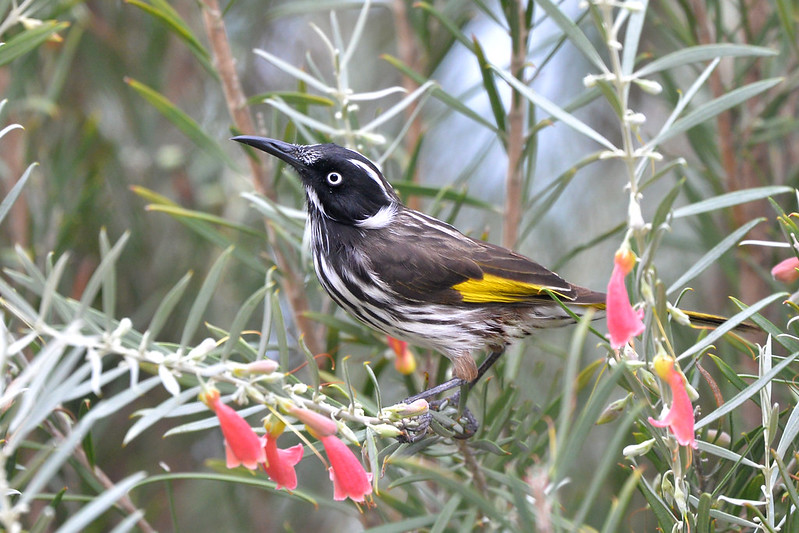Land of the Birds: What Sets Australia’s Avian Life Apart?
By Reade Barnett,
Geologist and Environmental Scientist, The University of Melbourne

Do you ever wake up to the cheerful chirps of rainbow lorikeets? Or the gentle warbles of the magpie? For many of us living in Australia, the day often begins with the melodious greeting of birds perched in nearby trees, on rooftops, fences, or even outdoor furniture. While these morning melodies are part of our daily lives, many of us are unaware of how unique and special the birds around us are.
Australia is home to a rich diversity of birdlife, with over 830 species – nearly one-tenth of the world’s bird species.1 Around 45% of these are endemic to Australia, meaning they are found nowhere else in the world.1 Not only is Australia’s birdlife remarkably species-rich, but its birds are very distinctive.
All the colours of the rainbow
Australia’s birds are renowned for their unique physical characteristics – most notably, their dazzling colouration. Many groups, such as parrots, cockatoos, pigeons, kingfishers, and fruit doves, exhibit vibrantly coloured feathers. To have birds as colourful as these in our own backyard is certainly unusual by world standards.
Feathered giants
Australia is also home to two of the world’s tallest and heaviest birds: the flightless cassowary and the emu.2 These two birds are likely to have diverged from a common ancestor around 25-30 million years ago.3 This common ancestor would have lived alongside dinosaurs and is believed to have flown, but the descendant large-bodied birds likely lost their ability to fly as they evolved and diversified.3
Not only do our birds offer a marvellous display of physical beauty, but they also exhibit unique behaviours. As biologist Tim Low notes, compared to birds in other regions of the world, Australia’s birds are “more likely to be intelligent, aggressive, loud, long-lived, ecologically powerful and to live in complex societies.”4 But why is this the case? And what makes our birds so unusual?
Isolation: The Catalyst for Evolution
Australia’s unique birdlife owes much of its distinctiveness to the continent’s geographic isolation. For millions of years, Australia was part of the ancient supercontinent Gondwana.5 Around 35 million years ago, Australia completely separated from its Gondwana neighbour Antarctica, and it has remained geographically isolated since.5
This isolation enabled Australia’s bird inhabitants to evolve separately. Without the influx of bird species from neighbouring landmasses, our birds adapted to a diverse range of habitats and ecological niches on their own. As a result, Australian birds have developed distinctive behaviours and adaptations.
Fighting for Food
Australia’s distinctive Eucalypt forests have also played a major role in shaping our bird evolution. For example, Australian honeyeaters evolved to utilise long, curved beaks and “brush-tipped” tongues that allow them to extract nectar thinly spread over large surface areas on flowering Eucalyptus and Grevillea.6
The nectar from Eucalyptus and Grevillea is a highly “fought-after” resource among Australian birds.4 Unlike bird species in other regions of the world, Australian birds are extremely territorial and aggressive. Honeyeater family birds such as the wattlebird and noisy miner fend off other birds to defend and guard their nectar sources. (This could explain why Australian birds are notably raucous and bombastic.) However, any bird driven away from one plant will only move to the next, and is therefore continually moving pollen between them. So, perhaps it’s a good thing Australian birds fight like children!
Unforgiving Environments
Many scientists believe that Australia’s harsh and unforgiving climate is what makes its birds unique.7 Australia’s environment ranges from arid deserts to lush, wet tropical rainforests. This diversity of climatic conditions has forced bird species to be innovative and adaptable, and to evolve in extraordinary ways.8 In fact, most of the world’s bird species (including all songbirds and parrots) can trace their ancestry back to Australia.9
But land clearing and Australia’s changing bushfire regimes are driving our highly evolved birdlife to the brink of no return.
Whether you’re a seasoned ornithologist, a casual birdwatcher, or simply someone who appreciates the wonders nature has to offer – Australia’s birdlife is something we should all appreciate and try our best to protect. Next time you hear the melodies of our feathered friends, remind yourself of the incredible journey it took for them to exist as they are.
—
Reade Barnett completed a Master of Ecosystem Management and Conservation at the University of Melbourne.
References:
- Chapman, A.D. (2009). Numbers of Living Species in Australia and the World – Detailed discussion by Group: Chordates. Australian Biodiversity Information Services. https://www.dcceew.gov.au/science-research/abrs/publications/other/numbers-living-species/discussion-chordates
- Australian Geographic Staff. (2018, October 9). Australia’s big birds. Australian Geographic. https://www.australiangeographic.com.au/topics/wildlife/2018/10/australias-big-birds/
- Rainforest Rescue. (2023). Save the Cassowary: Evolution. https://www.rainforestrescue.org.au/save-the-cassowary/evolution
- Low, T. (2016). Where Song Began. Yale University Press.
- Encyclopædia Britannica. (2019). Australia – Geologic history. In Encyclopædia Britannica. https://www.britannica.com/place/Australia/Geologic-history
- Paton, D. C., & Collins, B. G. (1989). Bills and tongues of nectar-feeding birds: A review of morphology, function and performance, with intercontinental comparisons. Austral Ecology, 14(4), 473–506. DOI: 10.1111/j.1442-9993.1989.tb01457.x
- Heathcote, A. (2020, January 23). Australia’s birds have evolved with the continent’s extreme weather, but not under these circumstances. Australian Geographic. https://www.australiangeographic.com.au/topics/wildlife/2020/01/australias-birds-have-evolved-with-the-continents-extreme-weather-but-not-under-these-circumstances/
- Meredith, P. (2017, November 24). Feathered geniuses: birds are much smarter than we think. Australian Geographic. https://www.australiangeographic.com.au/topics/wildlife/2017/11/bird-intelligence/
- Stiller, J., et al. (2024). Complexity of avian evolution revealed by family-level genomes. Nature, 629, 851-860. DOI: 10.1038/s41586-024-07323-1






